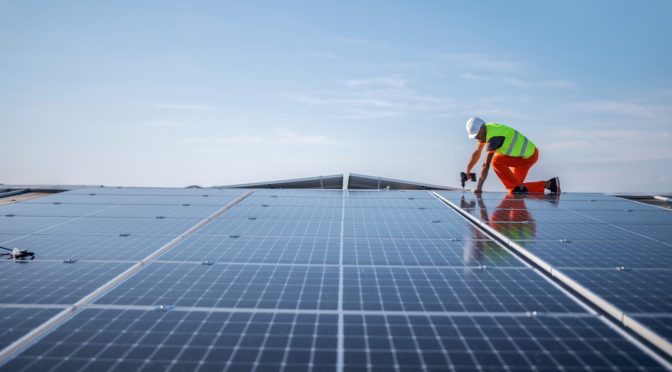Photovoltaic solar has become the second technology with the most megawatts installed and led electricity generation in May for the first time.
In 1984, 40 years ago, a space technology, used since 1958 outside of Earth, was established in Spain. Iberdrola then launched the first photovoltaic plant connected to the grid in San Agustín de Guadalix, with 100 kilowatts of power. It was a pilot project at the time, with an investment of 462 million pesetas, about 250,000 euros today. The solar expansion was not entirely meteoric and for almost a decade, the San Agustín de Guadalix photovoltaic plant remained the only one on the Peninsula.
Until that date, photovoltaics were barely used in some homes that lacked traditional electricity; and it would not be until ten years later when photovoltaic installations and the use of more sustainable energy sources began to arouse interest with a series of test projects, one of them the installation of solar panels at the Solar Energy Institute of the Polytechnic University of Madrid, at that time 13.5 kW peak. Even a plant in Toledo, which at that time, when it had up to 1MW installed, was the largest solar exploitation plant in Europe.
The approval of the Law for the Promotion of Renewable Energies and the Renewable Energy Plan was the necessary boost to today make photovoltaics the second technology with the most megawatts installed in Spain, ahead of gas combined cycles.
At the end of May, the Spanish generation park had a total of 125,622 megawatts of installed power, of which 31,219 MW belonged to wind energy, 26,543 MW to solar photovoltaic, 26,250 MW to combined cycle and 17,097 MW to hydraulic energy. , according to data from Red Eléctrica de España.
With these figures, photovoltaic solar now represents 21.1% of the total installed power in Spain, only surpassed by wind, which has a share of 24.9%. Both lead the electricity generation structure in Spain and are largely responsible – along with hydraulic and nuclear – for the fall in electricity prices over the past few months, in which all of them have pulled strongly on the system. The renewable quota now reaches 62.4%.
The acceleration has occurred since 2020, when photovoltaics has increased its installed power by 127.5%, going from 11,700 MW four years ago to the current 26,543 MW.
With these figures, photovoltaics begins to break barriers. Last May it became the leading technology in electricity supply for the first time, representing 23.8% of the total. It also occurred in a month with a 1.7% increase in demand, in line with the 1.2% increase accumulated so far this year.
Renewables generated 13,520 gigawatt hours in May, 16.4% more, and reached a share of 63%.
Record on May 24: 29% share
Solar panels produced 5,098 GWh in May, 31.6% more, a historical maximum for both production and quota. The record occurred on May 24, when the solar photovoltaic company broke its daily production record with 199 GWh, which represented a share of 29%, the highest in its history. Wind power was the second technology with the highest production, with 20.2% of the total, followed by nuclear power, with 16.5%, and hydraulic power, with 14.3%.
This May, 81.4% of the electricity produced in Spain was free of carbon dioxide (CO2) equivalent emissions.
In the accumulated of the year, wind power leads the contribution to the “mix”, with 25.2%; ahead of nuclear (18.3%), hydraulic (16.9%), solar photovoltaic (15.1%) and combined cycles (10.4%).
And the horizon is more than favorable for the sun because the weight of photovoltaics will continue to increase in the coming years thanks to the National Integrated Energy and Climate Plan (PNIEC). The decarbonization objectives for 2030 foresee that this technology will reach no less than 76 GW at the end of this decade, both for self-consumption and for ground-based plants, compared to 62 GW for wind power.
This greater presence of wind energy and photovoltaic in the generation “mix” in recent months, together with the discharge of hydraulics thanks to successive thaws and rain fronts, have brought the Spanish electricity market to minimum prices, even seeing in some hours of some days negative prices for the first time in history.
In fact, the average daily price of the wholesale electricity market, known as “pool”, registered its lowest month since it began operating in April, with 13.67 euros/MWh, and in May it closed at 30.4 euros/MWh.
Self-consumption should be added to the development of photovoltaics, which is lagging behind in Spain. In a recent report by Sotysolar and the photovoltaic employer association UNEF on self-consumption, it reveals that, although 22% of Spanish owners have installed solar panels or have started the process (requested information, have started the procedures or are seriously considering it), Only 5% have already installed solar panels in their single-family home or apartment, between 1 and 4 years old.
Of the rest of that 22% interested, 17% are potential consumers of solar energy, since they are seriously considering installing it or are already in the process of doing so, and 78% are not even considering it.
The areas of the northeast (Catalonia and the Balearic Islands), center and south (Andalusia) are the ones that have the most current solar panel customers. The Canary Islands stands out for being the area with the most potential clients in the process of installing or seriously considering installing, followed by the northwest area.
Living in a community of neighbors is the main obstacle for 40% of apartment owners and the high initial investment is for 25% of house owners. In the case of apartment owners, the fact of living in a block and dealing with the approval of neighbors acts as a barrier to installation (44%).


